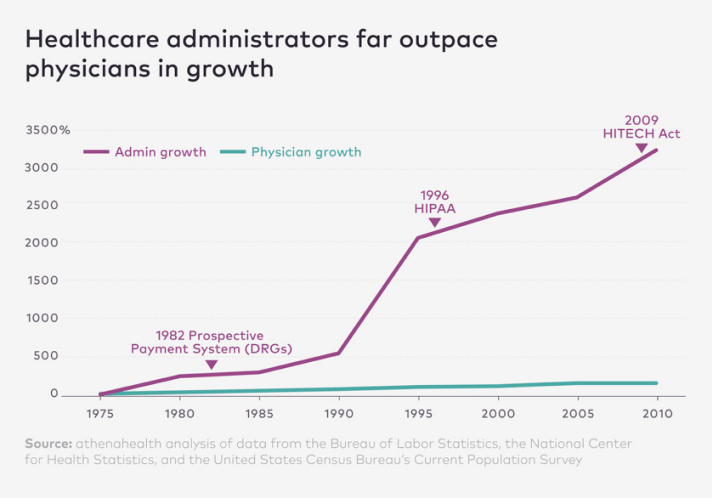How healthcare administrators can help improve quality and reduce burnout
Here's some food for thought: The number of physicians in the United States grew 150 percent between 1975 and 2010, roughly in keeping with population growth, while the number of healthcare administrators increased 3,200 percent for the same time period.
Yes, that's 3,200 percent in 35 years, a statistic derived by Physicians for a National Health Program using data from the Bureau of Labor Statistics, the National Center for Health Statistics, and the United States Census Bureau's Current Population Survey.

Supporters say the growing number of administrators is needed to keep pace with the drastic changes in healthcare delivery during that timeframe, particularly change driven by technology and by ever-more-complex regulations.
Critics say the army of administrators does little to relieve the documentation burden on clinicians, while creating layers of high-salaried bureaucratic bloat in healthcare organizations. In fact, administrators themselves are often burned out, but the right technology can provide relief and help them improve efficiency.
What is the role of an administrator in a modern healthcare setting — and what should it be? We spoke with healthcare leaders to get their take on administrator growth, the physician response, and the emerging role of physician-administrator in health systems. Here are edited excerpts from their observations.
The number of healthcare administrators has grown exponentially
Ben Bache-Wiig, M.D., is the executive vice president and chief clinical officer at Allina Health Group, headquartered in Minneapolis.
Bache-Wiig: I was surprised by the magnitude of the numbers, but not the direction. Healthcare as a business has fundamentally changed. It was a field dominated by small businesses in the 1970s — many physicians were solo practitioners with fairly minimal administrative help.
There has been a fundamental change in our business model, thanks to the astronomical changes of regulations and public reporting requirements. Automation and electronic medical records have actually not led to a workforce reduction. What's increased is the amount of support needed to make those systems work.
Louis J. Goodman, Ph.D., is executive vice president and CEO of the Texas Medical Association and a board member of The Physicians Foundation, where he previously served as president.
Goodman: There is a significant increase in the number of administrators, at a much more rapid rate than we are producing physicians. With the growth of administrators, we naturally are going to see an increase in rules, regulations and management procedures related to that “triple aim" that hospitals like to talk about [improved patient experience, overall population health, and reduced cost of healthcare].
The bottom line is that the increase has created a huge burden on physicians. For physicians, the focus is always on the patient. There's only one person that makes the key diagnostic and other decisions on behalf of the patient — and that's the doctor.
Marilu Bintz, M.D., is senior vice president of population health and strategy at Gundersen Health System in La Crosse, Wisconsin.
Bintz: Since the early 1980s, there has been a consolidation and aggregation of larger and larger physician groups in our health system, some affiliated with one or more hospitals. Then there's the trend of hospitals merging into larger networks. All of that introduces a level of complexity that has grown exponentially, and the degree of external regulatory requirements has also skyrocketed.
If we're saying the sheer number of administrators is compromising relations between physicians and patients, I disagree. I don't believe the number itself is a key factor. The key is for [physicians and administrators] to come together and deal with that complexity.
Nick A. Fabrizio, Ph.D., FACMPE, FACHE, is a principal consultant with the MGMA Health Care Consulting Group in Washington, D.C.
Fabrizio: I don't see what the data sees — big discrepancies in the numbers of administrators to physicians. In fact, I have seen hospitals taking away administrative operations people through mergers and combined joint ventures. I see that happening as positions are absorbed into the larger structure.
The physician-administrator relationship is changing
Fabrizio: A hospital health system is a complex environment that, by design, pumps up the number of administrators. A hospital may have multiple administrators running multiple service lines and vice presidents above them. For physicians moving there from a private or group practice, that could represent an immense change.
Bache-Wiig: In the 1970s, the hospital was seen as an open workshop where doctors brought their patients and worked largely independent of the hospital. Now, more than 50 percent of physicians are employed by hospitals and work in large specialty groups. They're being asked to follow protocols within a hospital system and report to administrators.
When administrators and clinicians come together as a team, that allows them to drive quality. When that trust is lost or broken, there is dysfunction.
Bintz: The growth in healthcare administration should in some part be a tool to help relieve physicians of administrative and clerical burden, which detracts from patient care and contributes to physician burnout.
Beyond that, the best way to improve the quality of care that patients receive is to have a strong partnership between physicians and administrators so that both understand the complexity of how "quality" is defined and reported, and both understand the real-life details of high-quality care at the bedside.
The benefits of physicians as healthcare administrators
Bintz: Health systems have to be more welcoming to physicians who want to be involved in administrative medicine. There needs to be a common understanding that the term physician-administrator does not require that a physician stop caring for patients. Physicians have to have the opportunity to be involved in administrative roles and continue to practice if that is their desire.
Bache-Wiig: There's been conscious effort in our health system to encourage physicians to take a leading role in the organization. I myself am a physician who had the opportunity to cross over and become successful as an administrator with excellent professional support throughout the system. That formula has been pretty successful for our four healthcare systems.
Goodman: More and more we're seeing an enhanced push toward physician-administrators, with more physicians going into administration through MHA and other degrees. Doctors have a greater sense that an administrator understands their concerns and is focused on the clinical side of patient care if that person is a physician-administrator rather than a lay administrator.
Interested in learning more? Try these related topics:
Burnout and staffing shortages are reshaping the front-office staff experience
Staffing challenges can magnify burden on those in healthcare administrative roles












